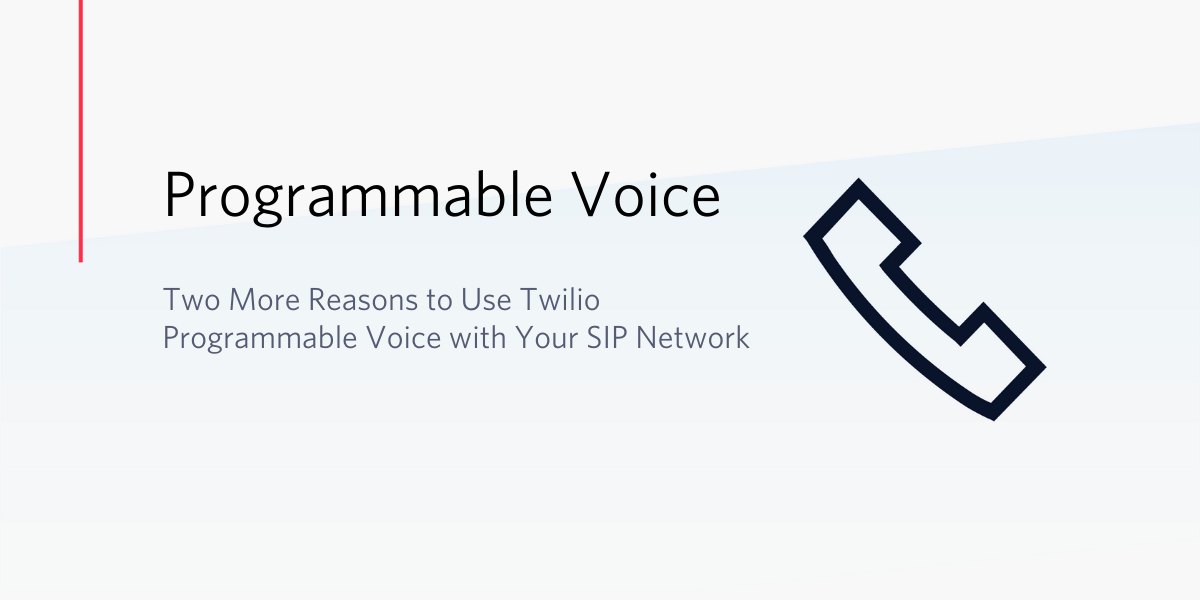Two More Reasons to Use Twilio Programmable Voice with Your SIP Network
Time to read: 3 minutes

As we continue to grow and develop our Programmable Voice portfolio, we are excited to announce the addition of new capabilities to enhance the overall user experience. These features will enable you to use the applications you have developed for PSTN and Client access interchangeably with your SIP endpoints too.
Support for Blind Transfer with addition of inbound SIP REFER to Twilio
The SIP REFER method enables moving an active SIP session from one SIP endpoint to another. In other words, REFER is used to implement call transfers on your SIP-connected calls. Until now, Twilio has only supported sending outbound SIP REFER messages to your SIP network, using the TwiML <Refer> verb.
Today, we are announcing support of inbound SIP REFER messages, meaning you now can send SIP REFER messages from your SIP network to Twilio in order to initiate call handling in your application. Effectively, this means that Twilio SIP calls now support "blind" call transfers using SIP REFER messages from your SIP communications infrastructure. Twilio will serve as the pivot-point and handle the call redirect, allowing you to free up resources in your IP communications infrastructure that are no longer needed.
How does it work?
The call transfers can be invoked on both inbound and outbound SIP calls. Your SIP endpoint will send a REFER containing a new destination in the Refer-To header, instructing Twilio to initiate a transfer. Twilio will accept the REFER, and will trigger a webhook to your application containing call data, including the contents of the message’s Refer-To header. Then your application can handle the webhook any way you want it to; a typical transfer scenario would involve initiating a new call to the intended destination, and bridging that call with the initial caller.
You can also send contextual information in your SIP REFER as a UUI header or Custom header by including it as part of the Refer-To header; the contents will be passed in the webhook as well, so your application can use it however you like.
For more information, check out the Inbound REFER documentation.
Introducing support for SIP multidial capability
Twilio Programmable Voice has always allowed you to simultaneously or sequentially call PSTN and Client endpoints using the TwiML <Dial> verb, and the <Number> and <Client> nouns. But until now, you were not able to dial more than one SIP endpoint using the <Sip> noun. Today, we have added that ability; you can now simultaneously or sequentially dial any mix of <Number>, <Client> or <Sip> endpoints, up to ten total targets in a single <Dial>.
How does it work?
Simultaneous or Sequential dialing to SIP endpoints works the same way as it does for other Programmable Voice endpoints.
Simultaneous Dialing
To dial multiple endpoints at the same time, just add multiple <Number>, <Client>, or <Sip> nouns to the same <Dial> verb. For example:
Sequential Dialing
To dial multiple endpoints in sequence, just add multiple <Number>, <Client>, or <Sip> nouns to the same <DIal> verb, and set the sequential parameter to true. For example:
For more information on Simultaneous and Sequential dialing, please see the full TwiML <Dial> documentation.
Twilio Programmable Voice allows you to augment your existing voice solutions with our cloud capabilities through a SIP interface, facilitating communications wherever you are. SIP Interface lets you power up your VoIP infrastructure with our cloud capabilities. Leverage or add functionality to your existing SIP network devices without costly or complicated equipment installations, and scale at the speed your business needs.
Multidial and blind transfer: two more reasons to use Twilio
Now that Twilio has added SIP multidial and blind transfer to our repertoire, we can enable even more use cases through Programmable Voice. To see how we can power your application, check out our features today. Or, to get started with the new functionality, enable the Enhanced Programmable SIP Features switch in your Programmable Voice settings.
Bill Harrison is a Product Manager of SIP and Voice Connectivity at Twilio. He spends way too much time reading PCAPs, discussing SIP, coaching youth hockey, and watching his beloved Boston sports teams. He can be reached at wharrison [at] twilio.com
Related Posts
Related Resources
Twilio Docs
From APIs to SDKs to sample apps
API reference documentation, SDKs, helper libraries, quickstarts, and tutorials for your language and platform.
Resource Center
The latest ebooks, industry reports, and webinars
Learn from customer engagement experts to improve your own communication.
Ahoy
Twilio's developer community hub
Best practices, code samples, and inspiration to build communications and digital engagement experiences.


